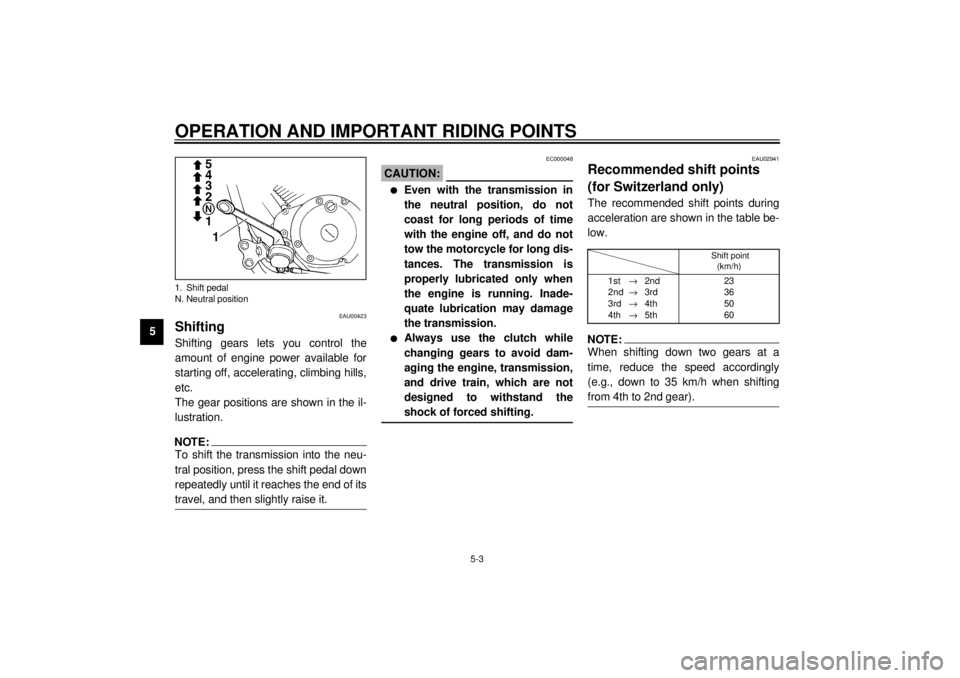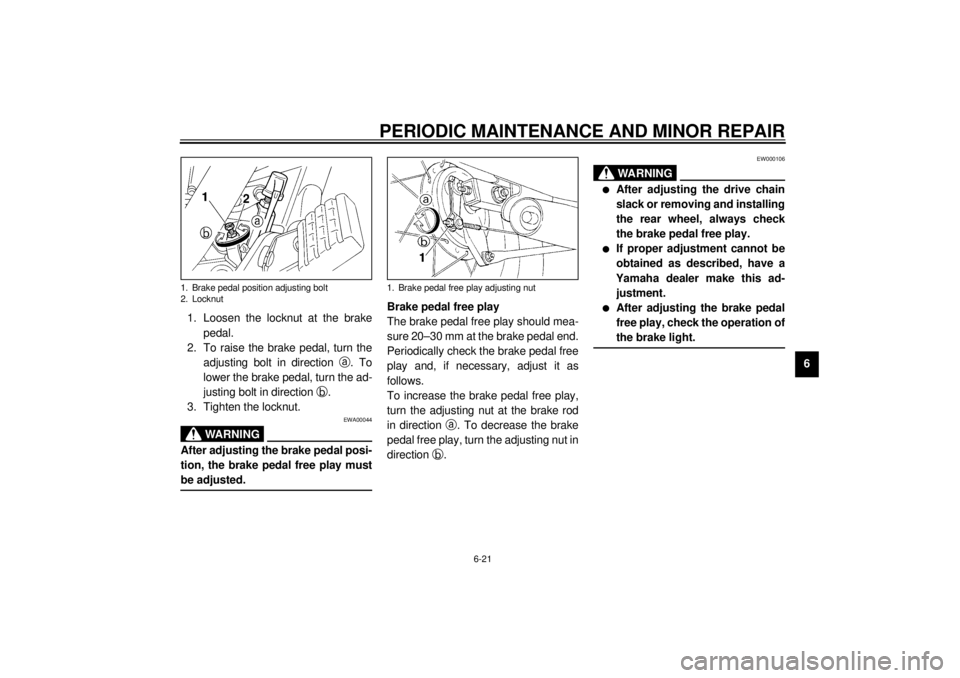Page 28 of 88

5-1
5
EAU00372
5-OPERATION AND IMPORTANT RIDING POINTS
EAU00373
WARNING
_ l
Become thoroughly familiar
with all operating controls and
their functions before riding.
Consult a Yamaha dealer re-
garding any control or function
that you do not thoroughly
understand.
l
Never start the engine or operate
it in a closed area for any length
of time. Exhaust fumes are poi-
sonous, and inhaling them can
cause loss of consciousness
and death within a short time. Al-
ways make sure that there is ad-
equate ventilation.
l
Before starting out, make sure
that the sidestand is up. If the
sidestand is not raised com-
pletely, it could contact the
ground and distract the opera-
tor, resulting in a possible loss
of control.
_
EAU03515*
Starting the engine In order for the ignition circuit cut-off
system to enable starting, one of the
following conditions must be met:l
The transmission is in the neutral
position.
l
The transmission is in gear with
the clutch lever pulled and the
sidestand up.
EW000054
WARNING
_ l
Before starting the engine,
check the function of the igni-
tion circuit cut-off system ac-
cording to the procedure
described on page 3-12.
l
Never ride with the sidestand
down.
_
1. Turn the fuel cock lever to “ON”.
2. Turn the key to “ON” and make
sure that the engine stop switch is
set to “ ”.
3. Shift the transmission into the neu-
tral position.NOTE:_ When the transmission is in the neutral
position, the neutral indicator light
should be on, otherwise have a
Yamaha dealer check the electrical
circuit. _1. Arrow mark positioned over “ON”
E_5kr.book Page 1 Tuesday, September 12, 2000 4:46 PM
Page 30 of 88

OPERATION AND IMPORTANT RIDING POINTS
5-3
5
EAU00423
Shifting Shifting gears lets you control the
amount of engine power available for
starting off, accelerating, climbing hills,
etc.
The gear positions are shown in the il-
lustration.NOTE:_ To shift the transmission into the neu-
tral position, press the shift pedal down
repeatedly until it reaches the end of its
travel, and then slightly raise it. _
EC000048
CAUTION:_ l
Even with the transmission in
the neutral position, do not
coast for long periods of time
with the engine off, and do not
tow the motorcycle for long dis-
tances. The transmission is
properly lubricated only when
the engine is running. Inade-
quate lubrication may damage
the transmission.
l
Always use the clutch while
changing gears to avoid dam-
aging the engine, transmission,
and drive train, which are not
designed to withstand the
shock of forced shifting.
_
EAU02941
Recommended shift points
(for Switzerland only) The recommended shift points during
acceleration are shown in the table be-
low.CF-01ENOTE:_ When shifting down two gears at a
time, reduce the speed accordingly
(e.g., down to 35 km/h when shifting
from 4th to 2nd gear). _
1. Shift pedal
N. Neutral position
Shift point
(km/h)
1st®2nd
2nd®3rd
3rd®4th
4th®5th23
36
50
60
E_5kr_Operation.fm Page 3 Wednesday, September 13, 2000 1:18 PM
Page 31 of 88

OPERATION AND IMPORTANT RIDING POINTS
5-4
5
EAU00424
Tips for reducing fuel
consumption Fuel consumption depends largely on
your riding style. Consider the following
tips to reduce fuel consumption:l
Thoroughly warm up the engine.
l
Turn the starter (choke) off as
soon as possible.
l
Shift up swiftly, and avoid high en-
gine speeds during acceleration.
l
Do not rev the engine while shift-
ing down, and avoid high engine
speeds with no load on the engine.
l
Turn the engine off instead of let-
ting it idle for an extended length
of time (e.g., in traffic jams, at traf-
fic lights or at railroad crossings).
EAU01128
Engine break-in There is never a more important period
in the life of your engine than the period
between 0 and 1,600 km. For this rea-
son, you should read the following ma-
terial carefully.
Since the engine is brand new, do not
put an excessive load on it for the first
1,600 km. The various parts in the en-
gine wear and polish themselves to the
correct operating clearances. During
this period, prolonged full-throttle oper-
ation or any condition that might result
in engine overheating must be avoided.
EAU03183
0–1,000 km
Avoid prolonged operation above
1/3 throttle.
1,000–1,600 km
Avoid prolonged operation above
1/2 throttle.
ECA00058
CAUTION:_ After 1,000 km of operation, the en-
gine oil must be changed, and the
oil filter element replaced. _1,600 km and beyond
The vehicle can now be operated
normally.
EC000049
CAUTION:_ If any engine trouble should occur
during the engine break-in period,
immediately have a Yamaha dealer
check the vehicle. _
E_5kr.book Page 4 Tuesday, September 12, 2000 4:46 PM
Page 36 of 88
PERIODIC MAINTENANCE AND MINOR REPAIR
6-4
6
EAU03541
NOTE:_l
The air filter needs more frequent service if you are riding in unusually wet or dusty areas.
l
Hydraulic brake service
• Regularly check and, if necessary, correct the brake fluid level.
• Every two years replace the internal components of the brake master cylinder and caliper, and change the brake fluid.
• Replace the brake hoses every four years and if cracked or damaged.
_26
*Air induction system• Check the air cut valve and reed valve for damage.
• Replace the entire air induction system if necessary.ÖÖÖÖ Ö
27*Lights, signals and
switches• Check operation.
• Adjust headlight beam.ÖÖÖÖÖ Ö NO. ITEM CHECK OR MAINTENANCE JOBODOMETER READING (´1,000 km)
ANNUAL
CHECK
1 10203040
E_5kr.book Page 4 Tuesday, September 12, 2000 4:46 PM
Page 40 of 88

PERIODIC MAINTENANCE AND MINOR REPAIR
6-8
6
EAU03329
Checking the spark plugs The spark plugs are important engine
components, which are easy to check.
Since heat and deposits will cause any
spark plug to slowly erode, the spark
plugs should be removed and checked
in accordance with the periodic mainte-
nance and lubrication chart. In addition,
the condition of the spark plugs can re-
veal the condition of the engine.
To remove a spark plug
1. Remove the spark plug cap.2. Remove the spark plug as shown,
with the spark plug wrench includ-
ed in the owner’s tool kit.To check the spark plugs
1. Check that the porcelain insulator
around the center electrode on
each spark plug is a medium-to-
light tan (the ideal color when the
motorcycle is ridden normally).
2. Check that all spark plugs installed
in the engine have the same color.
NOTE:_ If any spark plug shows a distinctly dif-
ferent color, the engine could be defec-
tive. Do not attempt to diagnose such
problems yourself. Instead, have a
Yamaha dealer check the motorcycle. _3. Check each spark plug for elec-
trode erosion and excessive car-
bon or other deposits, and replace
it if necessary.
1. Spark plug cap
1. Spark plug wrench
Specified spark plug:
CR6HSA (NGK) or
U20FSR-U (DENSO)
E_5kr.book Page 8 Tuesday, September 12, 2000 4:46 PM
Page 42 of 88

PERIODIC MAINTENANCE AND MINOR REPAIR
6-10
6
EAU01523
Engine oil and oil filter
element The engine oil level should be checked
before each ride. In addition, the oil
must be changed and the oil filter ele-
ment replaced at the intervals specified
in the periodic maintenance and lubri-
cation chart.
To check the engine oil level
1. Place the motorcycle on a level
surface and hold it in an upright
position.NOTE:_ Make sure that the motorcycle is posi-
tioned straight up when checking the oil
level. A slight tilt to the side can result in
a false reading. _2. Start the engine, warm it up for
several minutes, and then turn it
off.3. Wait a few minutes until the oil set-
tles, and then check the oil level
through the check window located
at the bottom-right side of the
crankcase.
NOTE:_ The engine oil should be between the
minimum and maximum level marks. _4. If the engine oil is below the mini-
mum level mark, add sufficient oil
of the recommended type to raise
it to the correct level.To change the engine oil (with or with-
out oil filter element replacement)
1. Start the engine, warm it up for
several minutes, and then turn it
off.
2. Place an oil pan under the engine
to collect the used oil.1. Engine oil level check window
2. Maximum level mark
3. Minimum level mark
4. Engine oil filler capRight side
E_5kr.book Page 10 Tuesday, September 12, 2000 4:46 PM
Page 45 of 88
PERIODIC MAINTENANCE AND MINOR REPAIR
6-13
6 2. Remove the air filter case cover by
removing the screws.3. Remove the air filter element by
removing the screws.4. Lightly tap the air filter element to
remove most of the dust and dirt,
and then blow the remaining dirt
out with compressed air as shown.
If the air filter element is damaged,
replace it.
5. Install the air filter element by in-
serting it into the air filter case,
then installing the screws.
1. Air filter case cover
2. Screw (´ 4)
1. Air filter element
2. Screw (´ 3)
E_5kr.book Page 13 Tuesday, September 12, 2000 4:46 PM
Page 53 of 88

PERIODIC MAINTENANCE AND MINOR REPAIR
6-21
6 1. Loosen the locknut at the brake
pedal.
2. To raise the brake pedal, turn the
adjusting bolt in direction
a. To
lower the brake pedal, turn the ad-
justing bolt in direction
b.
3. Tighten the locknut.
EWA00044
WARNING
_ After adjusting the brake pedal posi-
tion, the brake pedal free play must
be adjusted. _
Brake pedal free play
The brake pedal free play should mea-
sure 20–30 mm at the brake pedal end.
Periodically check the brake pedal free
play and, if necessary, adjust it as
follows.
To increase the brake pedal free play,
turn the adjusting nut at the brake rod
in direction
a. To decrease the brake
pedal free play, turn the adjusting nut in
direction
b.
EW000106
WARNING
_ l
After adjusting the drive chain
slack or removing and installing
the rear wheel, always check
the brake pedal free play.
l
If proper adjustment cannot be
obtained as described, have a
Yamaha dealer make this ad-
justment.
l
After adjusting the brake pedal
free play, check the operation of
the brake light.
_
1. Brake pedal position adjusting bolt
2. Locknut
1. Brake pedal free play adjusting nut
E_5kr.book Page 21 Tuesday, September 12, 2000 4:46 PM